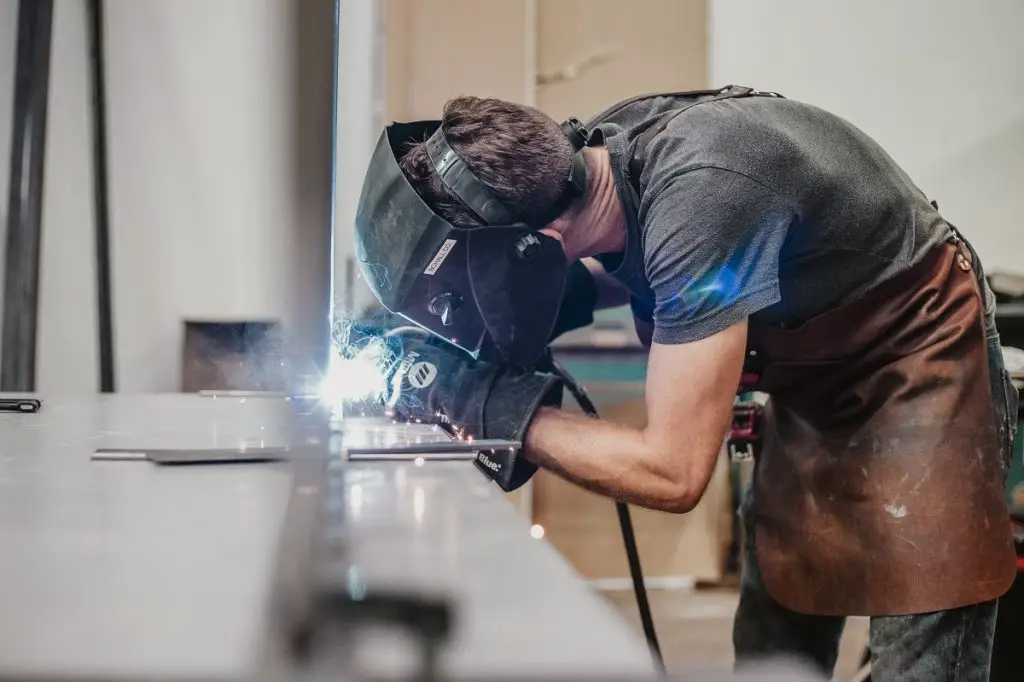When you’re welding, you need lots of protective welding equipment to safely do your job. One of the most important pieces of equipment is a welding helmet, which protects your vision and the sensitive parts of your face from the welding arc.
Many welders wonder why it’s important to wear a piece of equipment that makes you look like a sci-fi supervillain. How do these helmets work, especially the fancy new auto-darkening ones that seem to have more controls than you know what to do with?
Understanding how a welding helmet works is one of the most important things you must grasp for your safety as a welder. Here is my guide to help you protect yourself and have the best possible welding experience.

Table of Contents
What Is a Welding Helmet?
First, let’s establish what a welding helmet is. A welding helmet is protective equipment that goes over the face, head, and neck as you’re welding. It consists of a protective shield that goes over the face, top, and back of the head and a darkened visor that protects your vision. Eye protection is important because the flash from the welding arc can damage your eyes.
Welding helmets were first sold in 1937 by the company Willson Products. Since then, the welding helmet has evolved to include advanced technology and better materials to protect the face. There are a few different types of welding helmets, depending on the type of welding you are doing and the protection you need. The newest models include auto-darkening lenses, which automatically darken the shade to protect your eyes when the arc turns on.
Lincoln Electric Viking Auto Darkening Welding Helmet
- Large 12.5 Square Inch Auto Darkening Lens
- Premium Optics with a Crystal Clear View
- Comfortable Adjustable X6 Headgear
- 3 Year Warranty
Antra AH6 Auto Darkening Welding Helmet
- Full Face and Neck Protection
- Highly Responsive Arc Sensors
- Extremely Lightweight Design for Reduced Muscle Fatigue
- Sonar Panels Extend Battery Life
YESWELDER Solar Powered Auto Darkening Welding Helmet
- Suitable For TIG, MIG, MMA
- 8 Square Inch Viewing Area
- Comes with Replacement Lenses
- Comfortable Pivot Style Headgear
- Get 10% Off with Discount Code 'BWG' at Yeswelder.com
Components of a Welding Helmet
A proper welding helmet has a few different components that all work together to keep you safe. These include:
- A helmet shell, the hard material that goes over your face and head
- Cover plate, an additional level that goes over the shell to protect from radiation and other dangers
- Dials, to control the size since helmets have to be snug-fitting
- A filter lens, which blocks out the harmful light from the electrical arc
- Retainer lens, which is a piece of plastic that goes on the inside of the filter and prevents any shards from reaching your eye in case of an accident.
If you have an auto-darkening welding helmet, your lens contains a few additional components, including:
- Polarization filters, which darken the light as it comes through the lens
- UV/IR filter, the first layer on the lens, which blocks these harmful forms of radiation
- LC-Cell layers, which twist to reflect light
- Arc sensors, which detect light and adjust the shade of your lenses accordingly
How Does the Lens Work?
Of all the components listed above, the lens is one of the most important. The lens on the welding helmet protects your eyes from damage caused by the brightness of the welding arc.
Most traditional welding helmets are passive, so you have to put the visor with protective lenses down manually. Passive lenses have a visor that flips up or down, or a lens fitted permanently in place. For the lens to work, you fit your helmet so that the lens is securely over your eyes and flip the visor down. Then, the special coating on the lenses blocks out UV and infrared rays, protecting your eyes.
However, the downside of passive welding helmets is that when the welding arc is off, you can’t really see what you’re doing. The lens stays dark even if you don’t have anything to protect from. You either have to flip the visor up or take the helmet off.
How Does the Auto-Darkening Feature Work?
The way lenses work for helmets with an auto-darkening feature is quite different.
- Secure the helmet and turn it on. Use the adjustable gears to ensure the helmet securely sits on your head. Make sure the helmet is on, and the batteries are charged. The LC cells need power to adjust their positioning. During this step, you adjust the settings to the shade you want.
- The sensors detect light. The arc sensors will activate when you strike a welding arc.
- Polarization filters and LC-cells activate. The sensors send signals to the polarization filters to darken to the appropriate level. The LC cells activate by rotating, which reflects more light.
- The sensors turn off when you turn off the arc. Once you’re done welding, the sensors turn off the polarization filters, and the LC cells return to their normal position, allowing in normal light and letting you work.
The auto-darkening feature is great because you don’t have to manually move lenses or flip up visors when you’re done welding; the eye protection happens automatically.
Features of a Welding Helmet
A good welding helmet should have a few features, including:
- A full-coverage viewing area
- Controls for the functionality, including light sensitivity, delay, and more. Although auto-darkening helmets automatically adjust to the light outside, you still want control over the settings. Your eyes may be more sensitive than other people’s, so you want to give yourself the maximum protection.
- Controls for the fit so you can loosen or tighten the helmet
- Fast lens reaction time
- Lightweight helmet shield material
- Power source—different helmets use different batteries to power up
How to Test if It Works
Before you turn on your welding arc with your new welding helmet, an important safety precaution is to test if it works. You don’t want to find out the helmet isn’t working properly when you’re staring down the barrel of a very bright welding arc.
To test if your helmet works properly, put it on and adjust the settings. Then, look at the sun. The filters should darken quickly, adjusting to the change in light. If they are slow to change or don’t react to exposure to the sun’s rays, then your helmet probably isn’t working.
Other signs of a helmet not working anymore include a bright flash when you expose it to UV rays. While it will still work afterward, thanks to the built-in passive UV/IR filters, that is a sign that something is wrong with the auto-darkening feature, and you should start looking for a replacement helmet.
How to Maintain a Welding Helmet
Once you find a good welding helmet, you want it to work for a long time (plus, replacing those things is expensive). With the right maintenance, your helmet can stay in good condition for years to come.
Make sure you have replacement parts on hand, such as lenses, batteries, and sweatbands. Replacing parts is easier than replacing the whole helmet.
Properly store your welding helmet at all times. If you are welding in the field, invest in a good welding helmet bag which will protect the parts from any damage while you are in transit.
Clean your helmet regularly, especially if you notice debris on your lenses that prevent you from seeing properly. Wipe lenses with a soft brush and lens solution, then wipe dust and grime off of the rest of your helmet.

Final Thoughts
Welding helmets work by using UV and IR filters to protect your eyes from harmful rays. Auto-darkening welding helmets have automatic sensors that adjust the filters to the right darkness when you turn on the arc. Welding helmets are crucial pieces of safety equipment you should maintain properly so they can last a long time.



